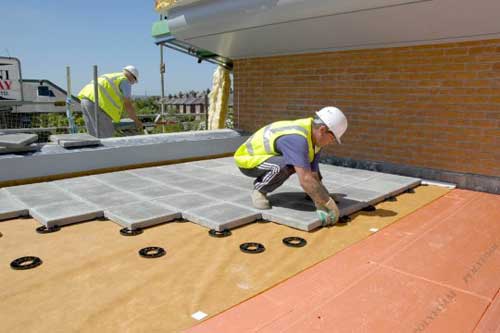Flat roof is most often used in the civil construction of industrial buildings and high-altitude structures. For some reason, such a type of roof can be very rarely found in private house-building, as many unreasonably consider it not so attractive in contrast, for example, from the pitched roof. Although it is the flat roof that has one important dignity - it is much cheaper than due to the smaller area. In addition, the flat roof allows you to more rationally use the space of the upper floor, it makes it easier to inspect and repair, and it can also be equipped under the terrace, summer garden, holiday platform, sports ground, etc.
A flat roof requires reliable thermal insulation, which allows you to significantly reduce the cost of home heating, improve the microclimate, and also increase the soundproofing of rooms adjacent to it.
Content
Selection of heat insulating material
The main point in the process of insulation of a flat roof is the competent selection of heat-insulating material, which must meet the following requirements:
- low thermal conductivity, which guarantees reliable protection of the house from heat and frost;
- fire safety;
- moisture resistance, which can prevent reproduction on the roof of harmful microorganisms, fungus and mold;
- parry permeability, which allows you to freely circulate air indoors and in case of excess moisture - to leave it out;
- resistance to mechanical damage, in particular point loads.
Today, the most common thermal insulation materials are considered to be mineral wool, foam, extruded expanded polystyrene foam, polyurethane foam. However, each of them has its drawbacks. For example, a foam is quite fragile material, and polyurethane foam or polystyrene foam does not always respond to fireproof criteria. Therefore, the most optimal option, specialists consider mineral wool, which meets all of the above criteria, and is also environmentally friendly and safe to the health of others.
Traditional and inversion roof, what is the difference?
The technology of insulation of flat roof depends on the type of roof itself, which is traditional or inversion. What is the difference?
The traditional roof is sobering, the so-called cake, which consists of the following layers:
- concrete or metal base;
- layer of vaporizolation;
- insulation;
- waterproofing;
- roofing material.
In contrast to the traditional roof, the inversion suggests the location of the heat-insulating layer on top of waterproofing, which additionally protects it from the effects of ultraviolet rays, as well as various climatic factors, and therefore significantly extends the service life of the roof itself. Therefore, if the roof itself is going to actively use, for example, to arrange a recreation area on it, the inversion roof is most suitable for these purposes.
Flat roof insulation process in traditional way
Flat roof can be insulated as outside and inside. Most often do it outside due to the ease of such works. So, consider in more detail the insulation of a flat roof in a traditional way.
- On the roof reinforced concrete base, we arrange a cement screed.
- Over we laid the waterproofing layer in order to protect the insulation from the water vapor. A steamproof film or sprayed materials (bitumen, polymer-bitumen), which are more effective, can be played as such a layer.
- Then, on top of the vaporizolation, lay the heat-insulating material (mineral wool from mining basalt rocks) into one or two layers, depending on the purpose of the room. Since the insulation most often represents a rolled material, then in the joints of the rolls, he must be laid by the flashes. At the same time, it is attached to the base with the help of telescopic dowels that cannot damage waterproofing, or glued to bitumeumes.
- After that, again layer waterproofing
- At the end of any finishing or bulk material.
More detailed process of insulation of flat roofing on video.
Insulation of inversion roof
The process of insulation of the inversion roof is almost identical to the previous one, with the exception of some details.
- A cement screed of the roof base is done.
- Then the waterproofing layer is placed, which is used as PVC film, EPDN - membrane, EuroRuberoid, various bitumen mastics, etc.
- Next layer of insulation in the form of extruded polystyrene foam.
- And covers with filtering material, such as glass christ. It is designed to pass water, but delay solid large particles.
- On top of such a cake, the last layer of pebbles or gravel or a pavement, floor tiles and so on, is stacked.
Inner insulation of flat roof
Warming with a flat roof from the inside is quite simple.
- To the ceiling at a distance of about 40 cm, wooden planks are screwed apart.
- In the intervals between them, the heat-insulating material in the form of polystyrene foam plates is close to the plarships with the help of special glue or mastic.
- Polyethylene film is fastened over the design over the entire surface of the ceiling.
- Next mounted decorative panels. They are screwed with galvanized nails straight to wooden planks.

























